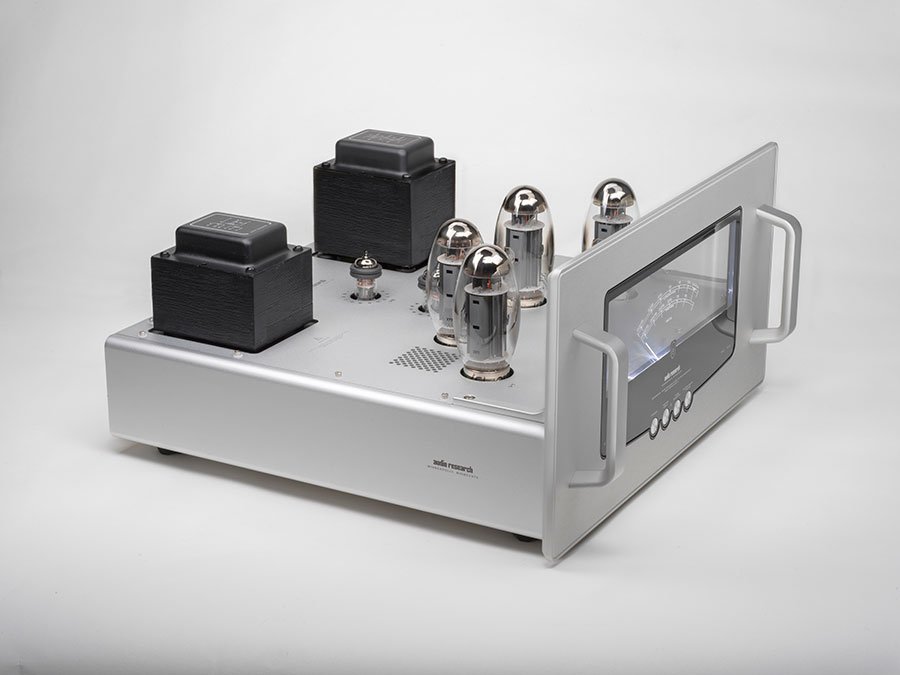

- #Audio research classic 150 monoblocks install#
- #Audio research classic 150 monoblocks manual#
- #Audio research classic 150 monoblocks skin#
- #Audio research classic 150 monoblocks plus#
#Audio research classic 150 monoblocks plus#
The Ref 250 is large - 19"W x 8.75"H x 19.5"D, plus another 1.5” for the handles - especially compared to the very compact MX-Rs. Seeing the high-quality circuit-board material (a dark tan substance known throughout the industry for its superior mechanical and dielectric qualities, not the ubiquitous green fiberglass) and elegant circuit traces, the distinctive transformers that dominate the center line, the banks of large KT120 output tubes and similarly oversized Teflon output capacitors to the left, and the fields of power-supply devices at front right and hugging the back of the faceplate (to cram in some 900 joules of storage capacity), no one need ask, “Where’s the beef?”Īfter installing the tubes, replacing the covers, and schlepping the amps onto the HRS M3 platforms just vacated by my Ayre Acoustics MX-R monoblocks, it was time to size up the ARCs. One benefit of performing such an installation is the intriguing tour of the Ref 250’s interior it compels. Luckily, each clearly marked tube (thank you, Sharpie) corresponded exactly to its waiting socket, as illustrated in the guide. This was more tedious than difficult - about 20 screws secure each amp’s clamshell cover.
#Audio research classic 150 monoblocks install#
While the typical customer should expect the dealer to personally deliver these amps, install the tubes, and connect the works, reviewers must fend for themselves.
#Audio research classic 150 monoblocks manual#
The total 22 tubes were extremely well protected, and labeled for proper and unconfused installation.Īfter I’d unpacked each 77-pound amplifier, it was time to read through the succinct instruction manual and make repeated use of the included screwdriver. In that one box, and for each of the two amplifiers, were three matched pairs of KT120 output power tubes, one matched pair of KT120 drivers, two 6H30 gain-stage and regulator drivers, and a 6550C regulator. What was unexpected was a somewhat smaller third box - unexpected but not a surprise, given that each Ref 250 requires 11 tubes. Between the inner and outer boxes is a six-sided cushion of Styrofoam the inner box further protects its contents from damage with closed-cell foam supports and a heavy-duty poly bag.
#Audio research classic 150 monoblocks skin#
As I’ve come to expect from ARC, the double-boxed packaging has a white outer skin emblazoned with the declarations “There Is Only One Reference” and “High Definition.” After 40-plus years, I guess ARC has earned such confidence. The Reference 250s arrived in two very large (about 25” square x 15”H), heavy (about 90 pounds each) boxes. With my system’s need for monoblocks, a set of Reference 250 amplifiers ($25,990/pair) was the natural place to begin my explorations. I was excited to see if the same would hold true for the power amplifiers.

The improvements in the preamplifiers have been startling, taking class-leading sound to a new level, based on my firsthand experience with and daily enjoyment of the Ref 5 SE and Ref Phono 2 SE, which I bought for use in my large reference system. Common to all are greatly enhanced power supplies, Teflon output capacitors, upgraded internal wiring, and other surgical changes. Special Editions of the Reference 5 preamplifier and Reference Phono 2 phono stage incorporated lessons learned from the Ref 40, and ARC’s earlier line of Reference 110, 210, and 610 power amplifiers have been replaced, respectively, by the Ref 150 stereo and the Ref 250 and Ref 750 monoblock models. It’s my opinion that the changeover sparked a period of invigorating challenge and exploration that has borne exceptional fruit, the most impressive evidence of which was the Reference Anniversary Preamplifier, aka the Ref 40 ($25,000 USD, when available during the company’s 40th anniversary year of 2011). Johnson retired in 2008, handed over the reins, and set ARC free.

Few companies in high-performance audio have a longer history or a greater pedigree. Many hi-fi manufacturers - even some industry stalwarts - begin, thrive, and ultimately die while still riding on the shoulders of their founders. Having been imbued with a set of core characteristics by founder William Zane Johnson, Audio Research Corporation was raised well, and was ready to live on its own when its progenitor approached his end. I suspect that when my parents shuffle off this mortal coil, another era of manhood will begin for me. I felt more a man after marrying my wife 15 years ago, and even more when my children were born. I can’t confirm the truth of that adage - my own father is alive and well - but I’ve found that certain life-altering experiences have triggered new levels of responsibility, capability, and growth. It’s said that a boy does not truly become a man until his father dies.


 0 kommentar(er)
0 kommentar(er)
